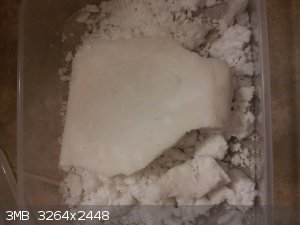UncleJoe1985
Hazard to Self
 
Posts: 88
Registered: 30-9-2008
Location: Sunnyvale, CA
Member Is Offline
Mood: No Mood
|
|
How to dry large amounts of hydroscopics like wet sucrose or sodium chlorate
I'm having difficulty drying my home made NaClO3. I've been heating it in a glass bowl on a hot plate for days with a 200mm computer fan
for circulation.
No kidding about it being hydroscopic. I estimate now there's only 100ml water per 1kg of NaClO3, but even that's enough to turn the mix
into a puddle of goo when the hot plate is set to 500F. It's like the water is dissolving in the salt instead of the other way around.
Here's what it looks like now. Looks like wet snow great for building igloos.

I can't drive out any more water this way because it's always the surface that dries first, trapping the remaining water inside.
So I'll need to break it up to expose much more area. But then I can't think of a way to heat such a large volume. I suppose leaving it outside in the
sun will work, but don't know how long it will take.
Tips anyone?
|
|
|
smaerd
International Hazard
    
Posts: 1262
Registered: 23-1-2010
Member Is Offline
Mood: hmm...
|
|
I don't know much about sodium chlorate other then that it is an oxidant.
One way I have dried hygroscopic materials was quite grueling. It required high vacuum, mechanical agitation and heating. For what I was drying that
meant a bunsen burner.
I wonder if a make shift kuegel rohr could suit your needs?
|
|
|
greenlight
National Hazard
   
Posts: 743
Registered: 3-11-2014
Member Is Offline
Mood: Energetic
|
|
What about a large dessicator or if you don't have one a large airtight tupperware container.
Use anhydrous Calcium chloride (Damprid from shop) as a dessicant layer on the bottom and place the sample to be dried on a piece of thick paper
towel.
Always works for me when I need to store Hexamine dinitrate if theres damp air; keeps it bone dry.
[Edited on 1-6-2015 by greenlight]
|
|
|
NedsHead
Hazard to Others
  
Posts: 409
Registered: 9-12-2014
Location: South Australia
Member Is Offline
Mood: No Mood
|
|
I though I had a tough time drying some freshly made silver nitrate but this dose look grueling. that being said, plenty of amateur pyros make large
batches of chlorate and manage to dry it somehow.
Maybe check out some pyro sites
|
|
|
jock88
National Hazard
   
Posts: 505
Registered: 13-12-2012
Member Is Offline
Mood: No Mood
|
|
They are usually drying K chlorate
|
|
|
Bert
Super Administrator
        
Posts: 2821
Registered: 12-3-2004
Member Is Offline
Mood: " I think we are all going to die. I think that love is an illusion. We are flawed, my darling".
|
|
If you have the time, the suggestion of a sealed chamber with dessicant below the hygroscopic material does work.
I have kept hygroscopic chemicals stored with dessicant in this fashion, and have used it with over the counter dessicants such as Damp Rid for drying
things like "smoke cookies" that want to stay soggy forever otherwise. (50:50 non dairy creamer/Potassium nitrate, made into a dough with water &
baked into small loaves for white smoke effects)
Vacuum chamber combined with heating and/or stirring is faster, and gives more repeatable results... if you can afford or cobble up the equipment-
The issue of a surface "skin" of dry material forming and trapping water inside lumps of chemicals or grains of mixtures ("driven in" water) is a
common one in pyrotechnic manufacture, also the migration of water soluble chemicals from center to exterior surfaces during drying of mixtures, with
concurrent imbalance of composition from center to surface of fabricated water bound grains/stars & etc.
[Edited on 1-6-2015 by Bert]
Rapopart’s Rules for critical commentary:
1. Attempt to re-express your target’s position so clearly, vividly and fairly that your target says: “Thanks, I wish I’d thought of putting it
that way.”
2. List any points of agreement (especially if they are not matters of general or widespread agreement).
3. Mention anything you have learned from your target.
4. Only then are you permitted to say so much as a word of rebuttal or criticism.
Anatol Rapoport was a Russian-born American mathematical psychologist (1911-2007).
|
|
|